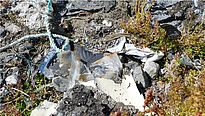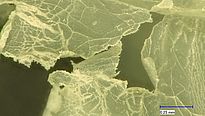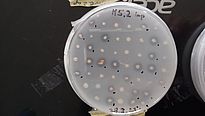Biodegradation of plastic at low temperatures
2020 - 2026
FinancingGlobal plastic pollution has become a pressing issue, posing threats to the environment and human well-being. The surge in plastic production and consumption, coupled with ineffective waste management strategies, has led to the accumulation of substantial quantities of plastic waste across diverse ecosystems, such as oceans, rivers and soil. Even very remote regions in the Arctic and the Alps are polluted with microplastic. Plastic-degrading microorganisms and their enzymes could help in making plastic recycling more sustainable.
Background
Finding, cultivating, and bioengineering organisms that can digest plastic not only aids in the removal of pollution, but is now also big business. Several microorganisms that can do this have already been found, but when their enzymes that make this possible are applied at an industrial scale, they typically only work at temperatures above 30°C. The heating required means that industrial applications remain costly to date, and are not carbon-neutral. But there is a possible solution to this problem: finding specialist cold-adapted microorganisms whose enzymes work at lower temperatures.
Aim
In this project we look for such bacteria or fungi in cold regions such as the Alps or the Arctic that can break down plastics. Moreover, we try to identify and characterise the plastic-degrading enzymes produced by the microbial strains. The use of the isolated enzyme instead of the organism itself would allow recovering the building blocks of the plastics which could then be used to produce new plastic. Making this huge potential accessible is one of our goals. We are interested in finding cold-adapted plastic-degrading microorganisms because of the potential to save energy due to their enzymes being active at lower temperatures.
Current developments
We discovered a remarkably large diversity of microorganisms inhabiting the surface of plastics (so called plastisphere) and isolated them. Many of these microbes are completely unknown in regard to their lifestyles and their abilities. We have identified several novel strains of cold-adapted specialist bacteria and fungi from the Alps and the Arctic region that can digest biodegradable plastics at 15°C. Moreover, we identified a few of these plastic-degrading enzymes produced by the microbial strains and tested them to degrade plastics under laboratory conditions.
Frequently asked questions
- When we digest plastic, what does it mean exactly and why is favorable for nature?
If we use microbes for plastic digestion, the process is similar to a composting process. The plastics are converted to CO2, water and microbial biomass. However, if we use the isolated enzymes of microorganisms, it is possible to recover the building blocks of the plastics which in turn could again be used to produce new plastic. This could result in fewer resources needed to produce new plastic. - What inspired us to look for microbes that can biodegrade plastic at low temperatures?
We were interested in finding cold-adapted plastic-degrading microorganisms because of the potential to save energy due to their enzymes being active at lower temperatures. In previous studies we observed that there is a remarkable diversity of microorganisms in the studied soils from alpine and Arctic regions. In addition, we found that many of the organisms found in these regions are still completely unknown and we therefore do not know a lot about their metabolic abilities. Moreover, we previously found that biodegradable plastics in these soils were colonized by a microbial community different from the soil that was not affected by plastic. From this finding we hypothesized that biodegradable plastics might select for microorganisms able to use the plastics as energy and nutrient source. - What makes our work stand out from others trying to harness these organisms' ability to remove pollution?
The novelty in our research is that our found microorganisms can efficiently degrade the tested biodegradable plastics at lower temperatures than most previous known organisms. From this we hope that we can find enzymes working at lower temperatures which might be used in enzymatic recycling applications in the future. - Are our microbial strains able to break down all types of plastic or only specific types?
The microbes were only able to break down biodegradable plastics. Conventional polyethylene was not degraded in the tested timeframe. - How long would it take for these microbes to biodegrade a significant amount of plastic?
That depends on whether the process can be scaled up or not. Currently we only did small-scale experiments where our most successful microbes degraded around half of a 4x4 cm plastic piece in two months. We also hope that the process can be significantly accelerated when using isolated enzymes rather than the microbes. Such enzymes may be produced at large amounts. - How can our findings be translated into practical applications for waste management and recycling industries?
At the moment we are still conducting basic research and it is too early to make predictions about the suitability of our found microbes for industrial applications. However, enzymatic recycling can in principle be used to recover the building blocks of plastics which can then be used to produce new plastic. - What are the limitations of the studies and what are the next steps?
The main limitation is that we so far only have found degradation of biodegradable plastics. These plastics are only a very minor portion of all produced plastics. In addition, so far we have not observed complete degradation of a whole piece of plastic. Further experiments are needed to see whether the whole plastic can be degraded. The next step will be to identify the plastic-degrading enzymes produced by the microbial strains. Then we want to learn more about important characteristics such as temperature optima and enzyme stability in order to optimize the process to obtain large amounts of proteins. This in turn will show, whether the new enzymes are suitable for an industrial process.
Publications
Articles in the media
-
SRF Einstein, 09.06.2023: Problem Plastikmüll – Fünf Lösungsansätze für unser Kunstoffproblem
-
Engelberger Dialoge, 26.10.2023: Mikrobieller Plastikabbau in alpinen Böden
-
Frontiers Science News, 10.05.2023: Scientists discover microbes in the Alps and Arctic that can digest plastic at low temperatures
-
BBC News, 11.05.2023: Plastic-eating microbes that work in colder temperatures discovered
-
WSL Blog, 03.10.2023: Southeast Greenland – collecting plastic waste in pristine bays
-
Elbe-Jeetzel-Zeitung, 05.10.2023: Klimawandel taut uralte Mikroben auf – Mikrobiologe im Interview
-
Swissinfo, 30.11.2022: Auch biologisch abbaubarer Plastik zersetzt sich nur sehr langsam
-
WSL News, 30.11.2022: Searching for plastic gobblers in alpine soils



